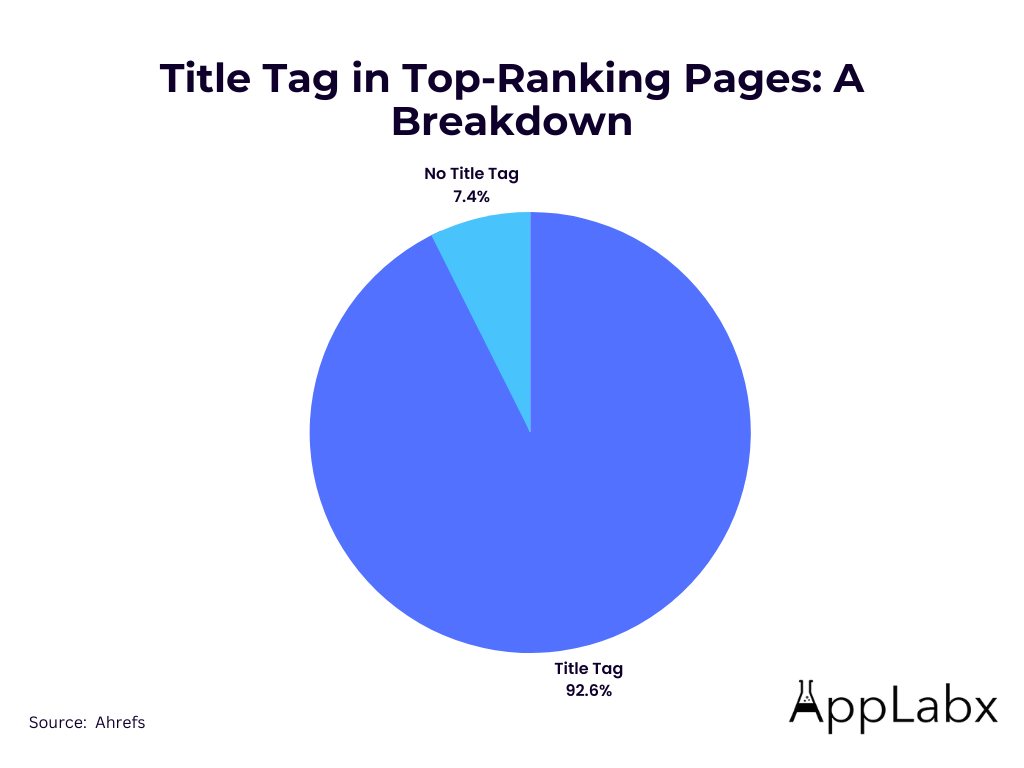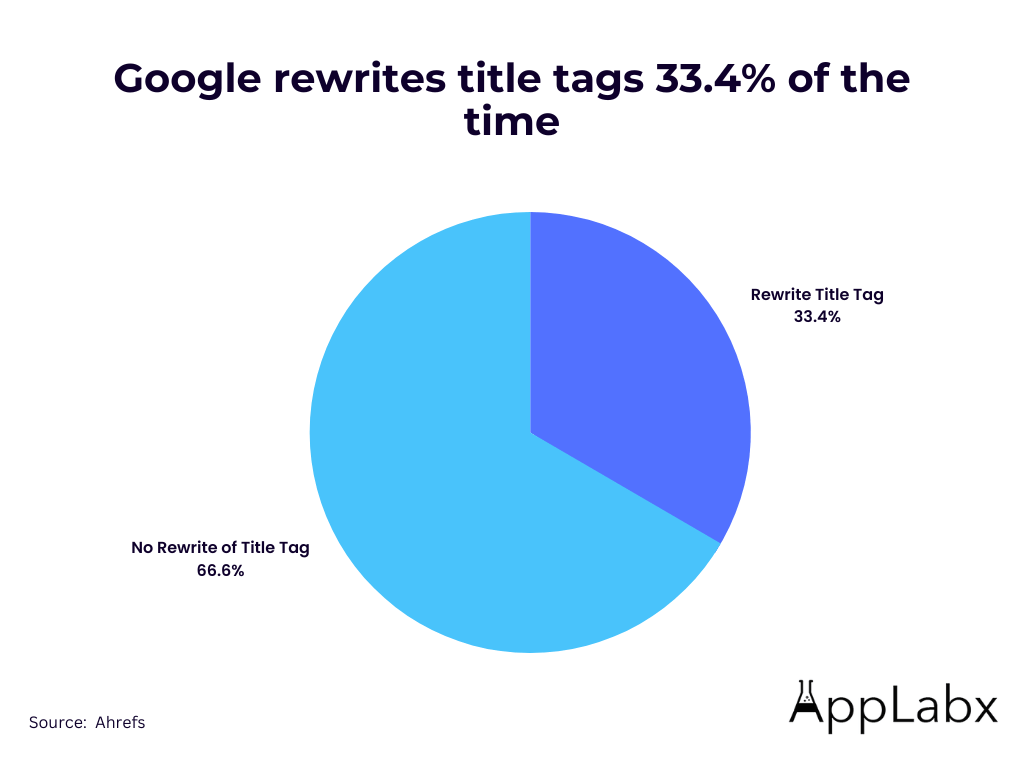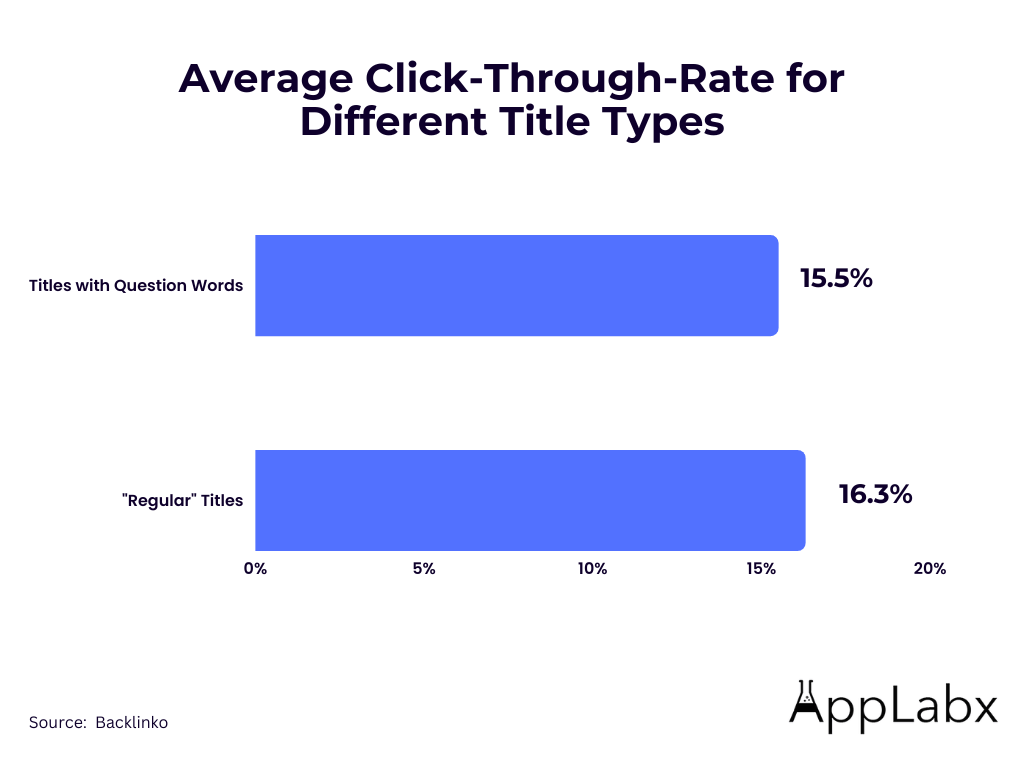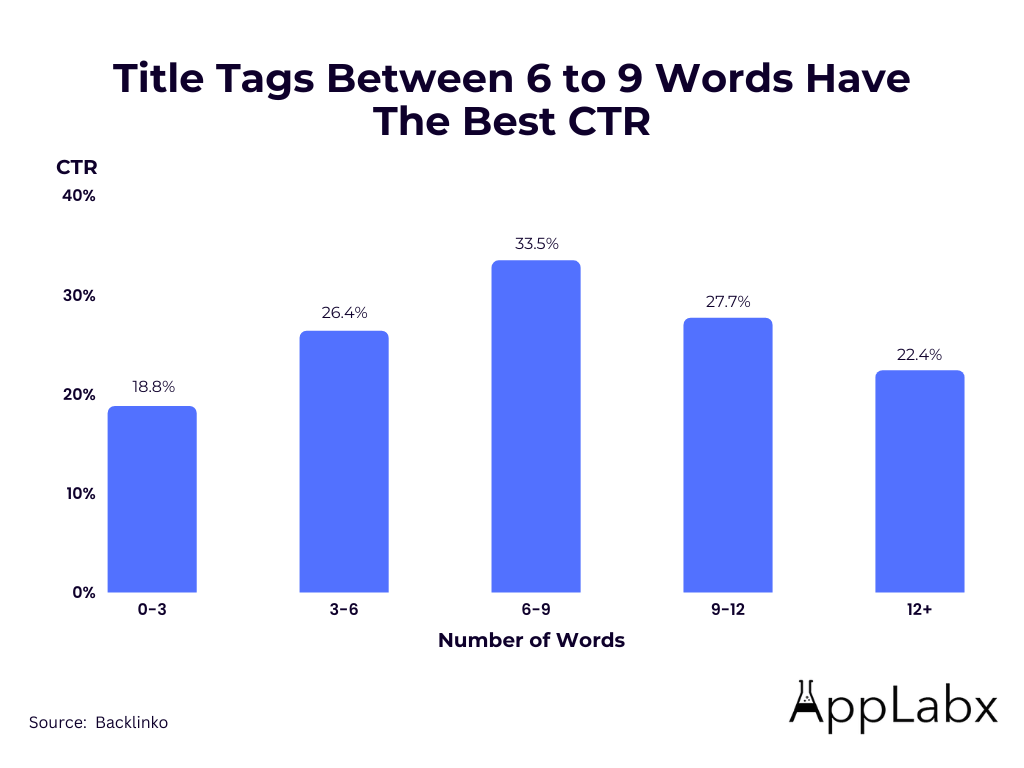Key Takeaways
- Optimal Length Matters: Discover the ideal character count for SEO title tags in 2023 (40-60 characters) to maximize organic click-through rates and enhance search visibility.
- Question Words Drive Engagement: Utilize question words strategically in your titles for a 15.5% higher click-through rate, capitalizing on user curiosity and boosting audience engagement.
- Mobile Optimization is Crucial: Prioritize mobile-friendly title tags and responsive design to cater to the growing mobile user base, ensuring seamless user experiences and improved search rankings in 2023.
In the fast-paced digital arena of 2023, mastering the intricate art of Search Engine Optimization (SEO) is not just a necessity but an indispensable strategy for online success.
Amidst the ever-changing algorithms and evolving user behaviours, understanding the power and potential of SEO Title Tags stands as a pivotal factor in achieving digital eminence.
Welcome to our in-depth exploration: “SEO Title Tag Statistics You Should Know in 2023 (Complete List & Latest).”
In the labyrinth of online visibility, the title tag of a webpage acts as its digital identity, a concise yet powerful descriptor of its content.
As we step into 2023, the dynamics of SEO title tags have undergone profound transformations.
This comprehensive guide is not just another collection of statistics; it’s a roadmap to decipher the nuances, unravel the mysteries, and harness the full potential of title tags in the current digital landscape.
Our journey delves into the heart of SEO, dissecting the trends that define high-ranking websites and uncovering the statistical gems that influence organic click-through rates.
We’ll navigate the realms of optimal character counts, exploring the delicate balance between informativeness and brevity that entices both users and search engines.
Furthermore, we’ll unveil the magic behind question words within titles, a strategy that not only captures attention but also elevates engagement rates significantly.
In this comprehensive exploration, we won’t just scratch the surface; we’ll plunge into the depths of mobile optimization.
With an ever-increasing number of users relying on smartphones and tablets, ensuring that title tags are not just visible but impactful on smaller screens becomes paramount.
We’ll unravel the strategies that make title tags resonate seamlessly across devices, ensuring a consistent and compelling user experience.
But this guide isn’t just about the ‘what’; it’s also about the ‘why’ and ‘how’.
We’ll explore the psychology behind user engagement, understanding the intricacies of user intent and how it intertwines with the crafting of the perfect title tag.
You’ll learn not just to optimize for search engines, but to resonate with your audience, driving genuine interest and interaction.
So, buckle up for a deep dive into the world of SEO Title Tag Statistics in 2023.
By the end of this comprehensive journey, you won’t just be informed; you’ll be equipped with actionable insights and strategies.
Whether you’re a seasoned digital marketer aiming to refine your techniques or a budding entrepreneur looking to make a mark online, this guide is your passport to navigating the complexities of SEO title tags in the digital age.
Get ready to revolutionize your online presence and embark on a transformative journey into the heart of SEO excellence.
Let the exploration begin.
Before we venture further, we want to share who we are and what we do.
About AppLabx
From developing a solid marketing plan to creating compelling content, optimizing for search engines, leveraging social media, and utilizing paid advertising, AppLabx offers a comprehensive suite of digital marketing services designed to drive growth and profitability for your business.
AppLabx is well known for helping companies and startups use SEO to drive web traffic to their websites and web apps.
At AppLabx, we understand that no two businesses are alike. That’s why we take a personalized approach to every project, working closely with our clients to understand their unique needs and goals, and developing customized strategies to help them achieve success.
If you need a digital consultation, then send in an inquiry here.
SEO Title Tag Statistics You Should Know in 2023 (Complete List & Latest)
- 7.4% of top-ranking pages don’t have a Title Tag
- Google rewrites Title Tags 33.4% of the time
- Google is now 33% more likely to rewrite Title Tags
- If Google ignores the Title Tag, it uses the H1 Tag 50.76% of the time instead
- Google 57% more likely to rewrite very long Title Tags
- Title elements are now used around 87% of the time
- 65-85% of top performers on any given keyword will have the exact same keyword included in their Title Tags
- Titles with question words in them have a 15.5% Click-Through-Rate (CTR)
- Title Tags between 40 to 60 characters have the best CTR
- Title Tags between 6 – 9 words have the highest CTR
- Positive titles have a 4.1% higher absolute CTR compared to negative titles
1. 7.4% of top-ranking pages don’t have a title tag
(Ahrefs)

7.4% of top-ranking pages, despite their prominent position, lack a fundamental element: a title tag. This seemingly minor omission carries significant implications in the sphere of search engine optimization. The title tag serves as a crucial descriptor, encapsulating the essence of a webpage’s content for both users and search engine algorithms. Its absence not only diminishes the page’s visibility and relevance but also hampers the user experience, as it provides vital context for the content displayed. This statistic underscores the meticulous attention to detail required in the digital landscape, emphasizing that even minor oversights can impact a website’s standing and user engagement. As such, it serves as a poignant reminder for webmasters and digital strategists to ensure comprehensive optimization encompassing every fundamental element for robust online presence.
For more information on title tags and how they work, read our top article here: SEO Title Tags: The Ultimate Guide for Best Practices and Tips
2. Google rewrites title tags 33.4% of the time
(Ahrefs)

Google, in its intricate algorithmic processes, undertakes a significant practice: it rewrites title tags with a frequency of 33.4%. This practice holds profound implications for digital marketers and website owners alike. Title tags play a pivotal role in shaping a webpage’s identity, serving as concise descriptors that offer both users and search engines a glimpse into the content’s essence. Google’s intervention in rewriting these tags highlights the search giant’s commitment to enhancing user experience by ensuring that the displayed titles accurately reflect the content’s relevance to a user’s query. This dynamic behavior underscores the need for meticulous crafting of title tags by webmasters, as it demonstrates that Google may alter them to better align with user intent and the context of the search query. This statistic underscores the ever-evolving nature of search engine algorithms, emphasizing the importance of staying attuned to these changes for effective digital optimization strategies.
3. Google is now 33% more likely to rewrite title tags
(Ahrefs)

In a notable shift, Google has exhibited a 33% increase in its propensity to rewrite title tags, signifying a substantial alteration in its search engine results page (SERP) practices. While Google has long been generating its own SERP titles and descriptions, the frequency of alterations to title tags has historically been lower compared to meta descriptions, which were rewritten 62.78% of the time. This change in trend becomes particularly evident when examining SERP titles for pages with unaltered title tags during the period between June and September 2021. The findings revealed a significant uptick in Google’s inclination to modify title tags, indicating a departure from the previously observed stability in this aspect. This shift underscores the dynamic nature of Google’s algorithms and highlights the need for digital marketers and website owners to closely monitor these changes, adapting their strategies accordingly to maintain optimal online visibility and relevance.
4. If Google ignores the title tag, it uses the H1 Tag 50.76% of the time instead
(Ahrefs)
In instances where Google opts to disregard the designated title tag, it resorts to the H1 heading 50.76% of the time, according to our comprehensive data analysis. This highlights the substantial role played by headings in shaping alternative search engine results page (SERP) titles. Notably, when disparities exist between the SERP title and the title tag, our findings reveal that Google predominantly extracts the SERP title from the H1 tag. This practice is observed 50.76% of the time, indicating a significant reliance on the primary heading structure of a webpage. Additionally, Google occasionally sources SERP titles from the H2 tag, although this occurs to a lesser extent, at 2.02% of the time. Furthermore, a combination of both H1 and H2 tags contributes to SERP titles in 1.31% of cases. These insights underscore the intricate nuances of Google’s algorithms, emphasizing the pivotal role of HTML heading tags in influencing the displayed titles on search engine results pages. Digital strategists and webmasters should take heed of these patterns, ensuring meticulous structuring of headings to optimize online visibility and user engagement.
5. Google 57% More likely to rewrite very long title tags
(Ahrefs)
In an intriguing development, Google displays a 57% higher tendency to rewrite title tags that exceed optimal length limits. Historically, titles exceeding 600 pixels in length were revised by Google 29.45% of the time. However, this figure has risen significantly to 46.12%, marking a substantial 56.6% increase. This highlights the critical importance of adhering to the 600px limit, aligning with what search engine results pages (SERPs) can effectively display. However, a more practical guideline, often deemed optimal for both user experience and search engine optimization, suggests maintaining titles within 60 characters. This shorter, concise format not only aligns with Google’s preferences but also enhances readability and click-through rates. Digital strategists are thus encouraged to prioritize brevity and clarity in their title tags, ensuring that the content fits within these parameters for maximum impact and visibility on SERPs.
6. Title elements are now used around 87% of the time
(Google)
In a significant update, Google has disclosed a noteworthy shift in its algorithms: title elements are now utilized approximately 87% of the time, indicating a perceptible increase from the previous rate of around 80%. This statistical insight sheds light on the enhanced significance placed on title elements in the context of search engine optimization (SEO). The title element, also known as the title tag, is a fundamental HTML attribute that succinctly describes the content of a web page. Google’s heightened reliance on this element underscores its pivotal role in determining the relevance and context of a webpage, directly influencing its visibility in search results. This update underscores the critical importance of crafting concise and compelling title tags, as they play a pivotal role in shaping a website’s online presence and its ability to capture the attention of both search engines and users. Understanding and optimizing this vital element has become even more imperative for digital marketers and website owners aiming to enhance their online visibility and engage their target audience effectively.
7. 65-85% of top performers on any given keyword will have the exact same keyword included in their title tags
(Bonzer)
In the intricate world of search engine optimization (SEO), a compelling pattern emerges: between 65% to 85% of top-performing web pages, specifically those dominating specific keywords, exhibit a striking commonality. These high achievers share a crucial characteristic—they incorporate the exact keyword they are optimizing for within their title tags. This statistical insight underscores a fundamental SEO strategy, emphasizing the pivotal role of the title tag in search engine algorithms. The presence of the targeted keyword in the title tag not only enhances the relevancy of the webpage to search queries but also bolsters its chances of securing a prominent position in search engine results. This revelation acts as a guiding principle for digital marketers and SEO specialists, highlighting the strategic importance of meticulous keyword research and its integration within the title tag to optimize a website’s visibility and maximize its potential to attract organic traffic. Understanding and leveraging this statistic can significantly enhance a website’s competitive edge in the online landscape.
8. Titles with Question Words in Them Have a 15.5% Click-Through-Rate (CTR)
(Backlinko)

Titles incorporating question words wield a remarkable influence on user engagement, boasting an impressive 15.5% click-through rate (CTR). This statistic sheds light on a distinctive and highly effective strategy employed in content marketing and digital advertising. Question words such as “how,” “what,” “why,” and “where” pique users’ curiosity, enticing them to delve deeper into the content to seek answers. This heightened level of engagement can be attributed to the psychological phenomenon where questions stimulate the audience’s desire for knowledge and solutions. Consequently, marketers and content creators can strategically leverage this insight by incorporating relevant question words into their titles, thereby significantly increasing the likelihood of users clicking through to explore the content further. Understanding the impact of linguistic nuances on user behaviour empowers digital strategists to craft titles that resonate profoundly with their target audience, enhancing both click-through rates and overall user experience.
9. Title Tags Between 40 to 60 Characters Have The Best CTR
(Backlinko)

Determining the optimal length for title tags is a nuanced task, often prompting questions about whether brevity or expansiveness yields higher click-through rates (CTR). Extensive analysis from our research provides a definitive answer: the sweet spot lies within titles comprising 40 to 60 characters. In the intricate realm of digital marketing, this range has emerged as the ideal length, showcasing the highest organic click-through rates. Titles within this character limit strike a delicate balance—they are concise enough to captivate attention and convey the essence of the content swiftly, yet comprehensive enough to offer meaningful insights. Such titles provide users with a clear preview of what to expect, enticing them to explore further. Understanding and implementing this nuanced approach to title tag length can significantly enhance a website’s visibility and user engagement, underscoring the strategic importance of careful character optimization in the competitive digital landscape.
10. Title Tags Between 6 – 9 Words Have the Highest CTR
(Backlinko)

In the intricate landscape of SEO strategies, the length of title tags stands out as a critical factor influencing click-through rates (CTR). Extensive analysis has revealed a compelling trend: title tags spanning 6 to 9 words exhibit the highest CTR. While the debate surrounding the SEO benefits of longer titles, often associated with the inclusion of a broader array of keywords, prevails, it is essential to note the nuanced dynamics at play. Shorter titles, it appears, possess an advantage in Google’s search algorithm due to precise query matching, resonating seamlessly with user intent. Additionally, our analysis suggests that CTR, the metric gauging the ratio of users clicking on a specific link to the number of total users viewing it, also contributes significantly to the efficacy of short and medium titles. This multifaceted perspective underscores the strategic importance of balancing keyword inclusion with concise, engaging titles, emphasizing the need for digital marketers to craft titles that are not only keyword-rich but also tailored to capture the audience’s attention effectively.
11. Positive titles have a 4.1% higher absolute CTR compared to negative titles
(Backlinko)
Our comprehensive analysis reveals a compelling trend in the realm of SEO: titles infused with positivity exhibit a 4.1% higher absolute Click-Through Rate (CTR) in comparison to their negative counterparts. This statistical insight underscores the significant impact of sentiment in shaping user engagement. Specifically, titles with a positive tone, featuring words such as “best,” “coolest,” or “healthiest,” demonstrate a notable increase in Organic Click-Through Rates. The psychological appeal of positivity plays a pivotal role, capturing the attention of users and enticing them to explore further. This phenomenon suggests that leveraging positive language not only enhances the perceived value of the content but also amplifies its appeal, ultimately leading to higher user interaction and, consequently, improved search engine visibility. Understanding the potency of positive titles provides digital marketers with a strategic advantage, empowering them to craft compelling narratives that resonate profoundly with their audience, fostering genuine connections, and driving higher organic traffic to their websites.
Conclusion
In the dynamic tapestry of digital marketing, understanding the intricate nuances of SEO Title Tag Statistics has never been more crucial than it is in 2023.
As we conclude this exhaustive exploration, we unveil a comprehensive treasure trove of insights, a roadmap designed to empower marketers, webmasters, and SEO enthusiasts with the latest and most profound knowledge shaping online visibility.
In the ever-evolving realm of search engine optimization, staying abreast of the most recent trends and statistics is akin to possessing a compass in uncharted territory, guiding you toward digital prominence.
Our deep dive into the world of SEO Title Tags has unveiled a myriad of revelations, each more illuminating than the last.
We’ve explored the optimal character count for title tags, unraveling the intricate balance between brevity and depth.
Titles spanning 40 to 60 characters have emerged as the sweet spot, capturing the attention of both search engines and users.
We’ve delved into the psychology behind question words within titles, understanding their unique power to intrigue and engage audiences, leading to a significant 15.5% click-through rate.
Furthermore, our analysis dissected the impact of mobile optimization, elucidating the paramount importance of responsive design in catering to the burgeoning mobile user base.
The journey has also taken us through the fascinating interplay of user intent and SEO strategies.
We’ve deciphered the subtle art of aligning content with user queries, ensuring that every piece of information meets the user’s expectations and fulfills their needs.
Understanding this delicate balance is not just an art; it’s the heart of successful digital marketing campaigns.
Moreover, our scrutiny of title tag length, from the debate between long-tail keywords to concise titles, has provided clarity.
Titles comprising 6 to 9 words have emerged as the champions, striking the perfect equilibrium between information and intrigue, resulting in higher click-through rates.
In the labyrinthine world of SEO, the role of data-driven insights cannot be overstated.
Our exploration has equipped marketers with a nuanced understanding of the latest algorithms, enabling them to craft compelling narratives that capture the essence of their brands while aligning seamlessly with user expectations.
The SEO Title Tag Statistics for 2023 have illuminated the path toward digital eminence, emphasizing the strategic importance of meticulous keyword research, precise messaging, and engaging content creation.
Armed with this knowledge, marketers are not just participants but architects, shaping the future of online engagement.
As we bid adieu to this exhaustive exploration, the imperative is clear: the pursuit of knowledge, coupled with strategic application, is the cornerstone of enduring success in the realm of SEO.
These insights, meticulously curated and presented, are not just facts and figures but powerful tools, empowering you to navigate the ever-changing currents of digital marketing with confidence and finesse.
In the vast expanse of the internet, where millions of voices vie for attention, understanding the pulse of SEO Title Tag Statistics is your key to standing out, forging genuine connections, and leaving an indelible mark in the digital sphere of 2023 and beyond.
May your strategies be sharp, your content compelling, and your digital journey marked by unparalleled success. Safe travels on your path to online eminence.
If you are looking for a top-class digital marketer, then book a free consultation slot here.
If you find this article useful, why not share it with your friends and business partners, and also leave a nice comment below?
We, at the AppLabx Research Team, strive to bring the latest and most meaningful data, guides, and statistics to your doorstep.
To get access to top-quality guides, click over to the AppLabx Blog.
People Also Ask
How do you write a title tag for SEO?
When crafting an SEO-optimized title tag, focus on the primary keyword or topic of the page. Keep it concise, ideally within 50-60 characters, and make it compelling to entice clicks. Include your brand name if possible, and ensure the title reflects the content accurately to enhance user experience and SEO ranking. Consider user intent and create a title that resonates with your audience, encouraging them to engage with the content. Avoid keyword stuffing and create unique, descriptive titles for each page on your website. A well-crafted title tag enhances visibility, click-through rates, and overall SEO performance.
Is the SEO title the title tag?
Yes, in the context of SEO, the “SEO title” refers to the title tag of a web page. It’s the HTML element specifying the title of a webpage displayed on search engine results pages (SERPs). Crafting an effective SEO title is vital for visibility and user engagement, as it summarizes the content concisely, incorporates relevant keywords, and entices clicks. Optimizing the title tag boosts search rankings and click-through rates, enhancing the overall SEO performance of the webpage.
What is a title tag example?
An example of a title tag for a bakery website: “Delicious Artisan Breads & Pastries | [Bakery Name]”. In this case, the title succinctly describes the content (artisan bakery products) within the character limit and includes the brand name, optimizing it for search engines and user engagement.
Source:
































